As we reflect on the evolution of remote work over the past four years since the onset of the COVID-19 pandemic, it's essential to understand the current state of remote work. To gain insights into this, a comprehensive analysis of 1 million remote job openings from the past two years was conducted. The analysis aimed to explore several key aspects of remote work trends, including the percentage of remote job postings, the types of jobs most likely to be remote, the prevalence of remote work in leadership roles compared to individual contributors, salary comparisons between remote and non-remote jobs, the popularity of remote work in different countries, the migration of remote jobs outside the US, and the impact of remote work culture on job satisfaction. The data for this analysis was sourced from Revealera.com, a company that provides job postings and hiring trends data to financial institutions, encompassing a diverse range of job opportunities from various industries and countries.
### Trends in Remote Job Postings
The analysis included an examination of the percentage of remote job postings over the past year to identify any discernible trends in the prevalence of remote work opportunities. This assessment aimed to determine whether the proportion of remote job openings has exhibited a gradual decline or remains consistently high, signifying the enduring nature of remote work.
### Types of Jobs Likely to Be Remote
An examination of the types of jobs most likely to be remote was conducted to identify whether certain roles, such as those in technology, marketing, or customer service, are more predisposed to remote work arrangements.
### Remote Work in Leadership Roles vs. Individual Contributors
A crucial aspect of the analysis involved comparing the likelihood of remote work arrangements for leadership positions against those for individual contributors. This investigation sought to ascertain whether leadership roles are more or less likely to be designated as remote compared to non-leadership roles.
### Salary Comparisons for Remote vs. Non-Remote Jobs
To provide a comprehensive perspective on remote work, the analysis included a comparison of salaries for remote jobs with those for non-remote positions. This comparison aimed to discern any variations in compensation between remote and traditional in-office roles.
### Popularity of Remote Work in Different Countries
In addition, the analysis delved into the geographical prevalence of remote work, identifying the countries where remote work is most popular and exploring which regions have experienced the highest growth in remote job opportunities. This assessment also considered whether there has been a notable increase in remote jobs located outside the United States.
### Impact of Remote Work Culture on Job Satisfaction
Lastly, the analysis involved an evaluation of the correlation between remote work culture and job satisfaction. This exploration aimed to determine whether companies with a strong remote work culture exhibit higher levels of employee satisfaction and engagement.
The findings of this comprehensive analysis are poised to shed light on the current trajectory of remote work, providing valuable insights into its prevalence, impact on job roles and salaries, geographical distribution, and influence on employee satisfaction. This analysis aims to offer crucial data-driven perspectives that can inform discussions about the future of remote work as we transition into a new era of work dynamics.
The share of remote job postings is up 10% from a year ago, and up 31% from 6 months ago, after a steady decline since mid-2022

After a steady decline since early 2022, the % share of remote jobs is starting to rise again. The % of global job postings listed as remote is up 10% from a year ago and 31% from 6 months ago. Interestingly, the share of remote jobs has increased even more in public companies than in startups.

The share of remote job postings for public companies rose 45% from a year ago and is almost at its all-time high in early 2022. In contrast, for startups, the share rose just 9.8% from a year ago.

It’s important to note that I’m looking at % of jobs that are remote, *not* raw numbers. The raw # of remote job openings has decreased from a year ago but that isn’t because companies are moving away from remote work, but because of tech layoffs that are happening across the board.
But still, why the recent increase percentage-wise? I don’t have definitive reasons, but for starters, I think a lot of return-to-office initiatives are finally over.
Second, companies are focused on cutting costs as much as possible. They’re looking for ways to save costs on real estate, and labor. And remote work helps with that. It opens up the talent pool by allowing companies to find talent in places with a lower cost of labor. After all, why hire that developer in SF who demands $250K, when you can hire someone just as capable in Michigan for $200K?
Unless there is another pandemic, we probably won’t be seeing a huge steep rise in remote jobs. But it seems most of the RTO initiatives have passed, and we may be seeing a “new normal” and the start of a slow secular increase in remote work.
Account executives, software engineers, and digital marketers are the top 3 most popular remote jobs
Which job titles have the most popular remote jobs?
If we look at just pure volume, account executives/managers, software engineers, and digital marketers make up the vast majority of remote job openings.
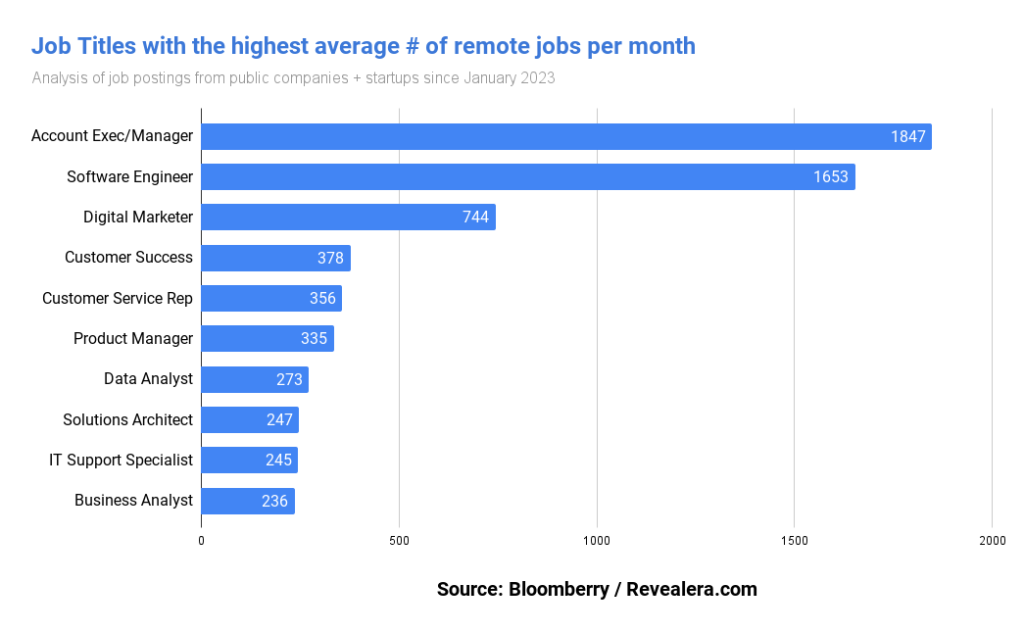
However, I think a more interesting analysis would be which jobs are *more likely* to be more remote-based. For this exercise, I took the total # of jobs listed for each job title and calculated the % that were remote.
If we calculated this way, technical writers, customer success specialists, and product designers are the most likely jobs to be remote.
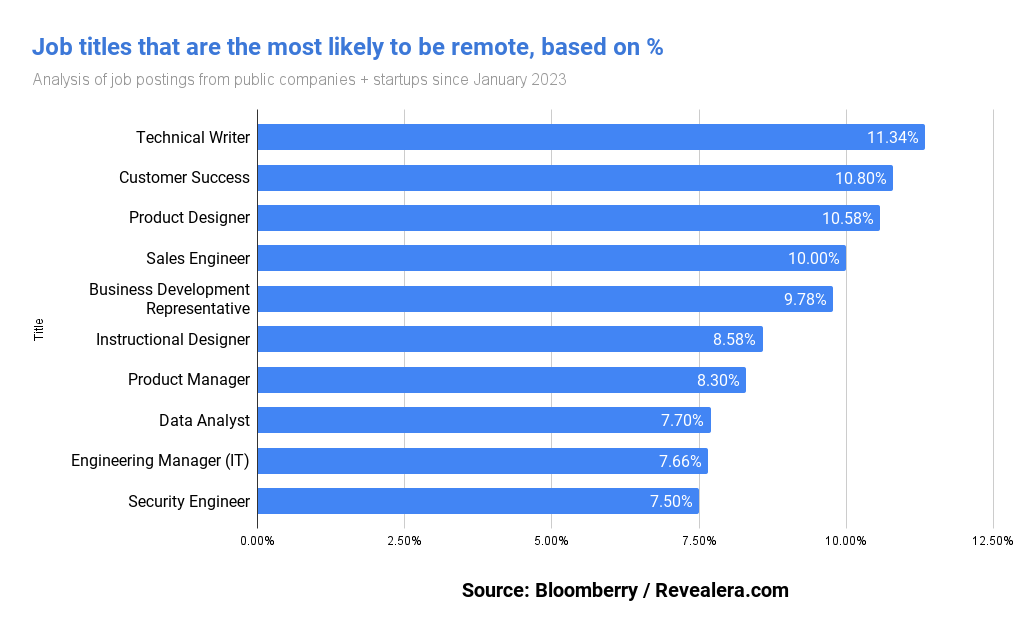
Director, VP, and Management job openings are more likely to be remote than Individual Contributors
This was the most surprising finding. 5.4% of all white-collar job postings in the VP and Director level from public companies were remote, while only 3% of individual contributor (non-management) job postings were remote.
This was a bit counterintuitive to me because I always thought specialized roles were more conducive to being remote, while senior leadership roles typically involve a significant amount of communication, which usually benefit from in-person interactions.
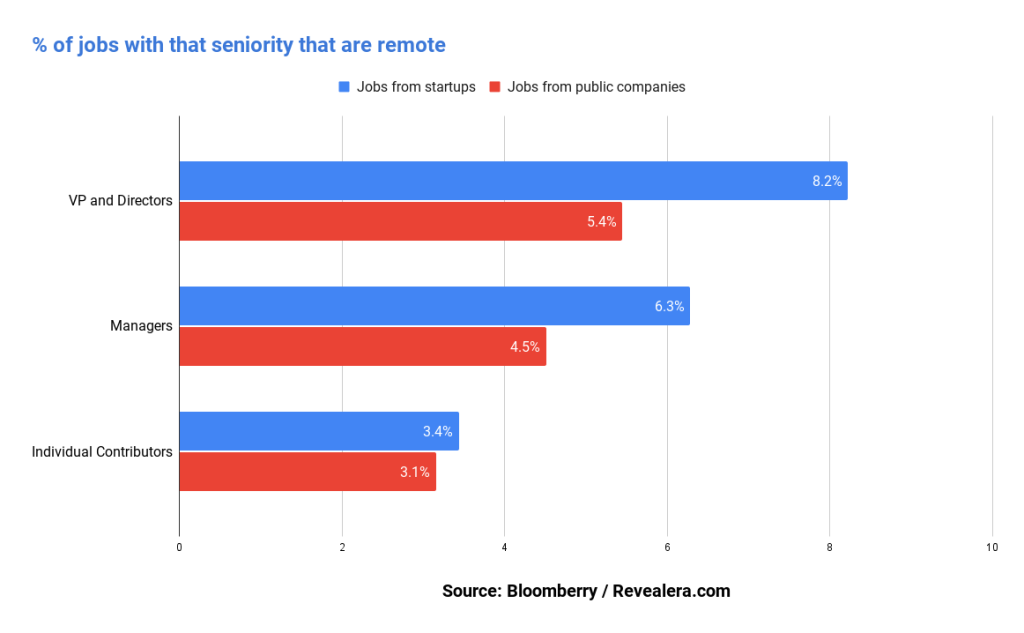
Remote jobs also require a bit more experience than non-remote jobs. The average # of years of experience required in remote jobs was 5.3, a bit more than the 4.3 years of experience required for non-remote jobs (with the same job title).
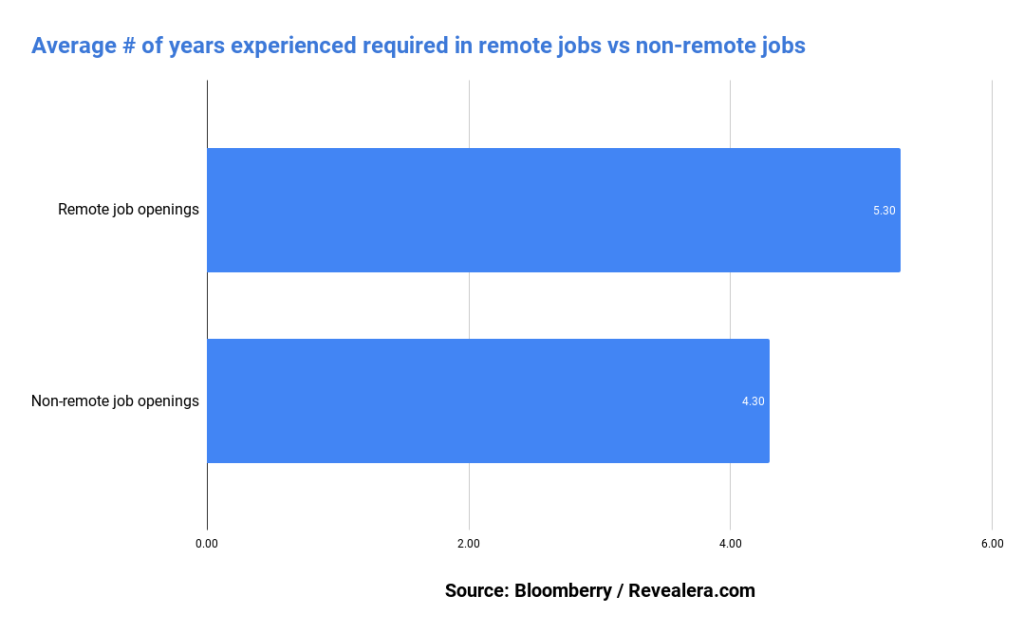
Among all the different levels, entry-level jobs were the least likely to be remote at 2.48%, while senior-level jobs were the most likely at 5.35%.
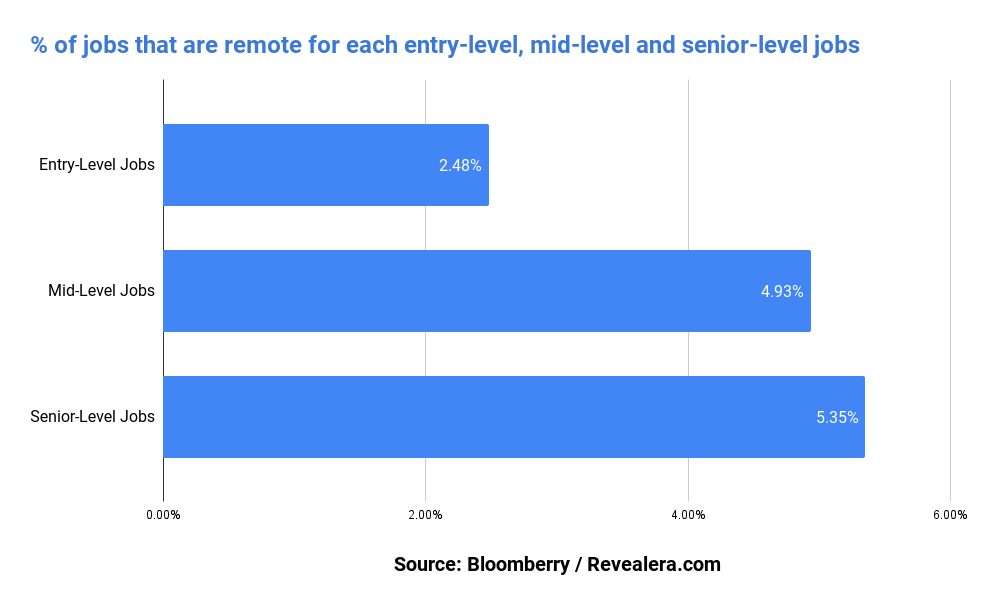
Putting all this data together, I think the story here is that companies simply require an enormous amount of trust in hiring someone to work remotely, and as a result, they’re more likely to give a remote jobs to senior leaders and people with lots of experience.
I think there’s also something to be said here for preferences based on what generation you’re in as well. Gen Z prefers working in the office, and the benefits it brings such as networking, mentorship, and a structured environment. While older workers may have families and kids to take care of and prefer working remotely.
Preferences for remote work depend on the profession and industry
Preferences for remote work also differ, depending on what profession and industry you’re in. I conducted a poll on Blind, a tech community mostly frequented by software engineers, and 66% of them told me they would prefer to work remotely 5 days a week.
We conducted the same poll to my Twitter audience (the vast majority of whom are in the financial/investment industry), and only 36% of them chose 5 days a week. 27% of them even would prefer working remotely just 1-2 days a week. A huge difference.
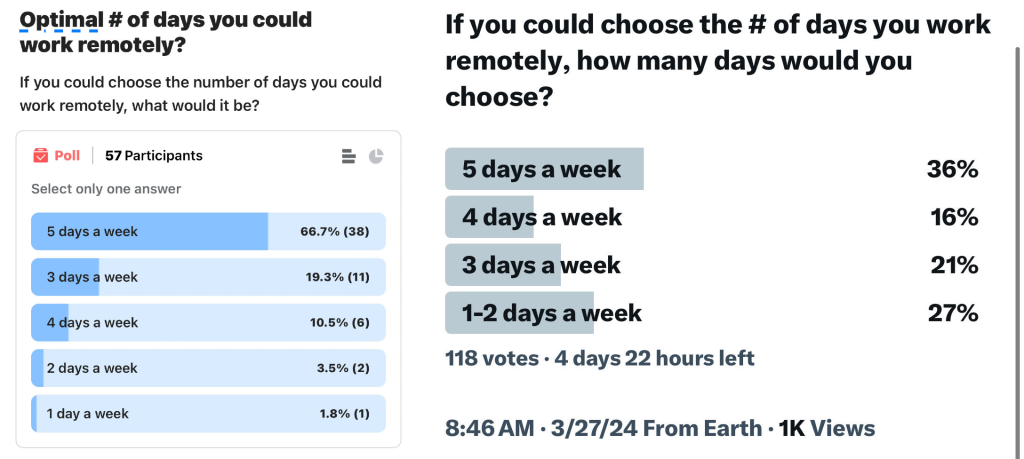
I think these poll results underscore the cultural differences between the tech and financial sectors, and the importance of culture fit when recruiting.
Someone who has all the credentials and experience, but has mostly worked in tech companies might not fit in a company like JPMorgan or Goldman Sachs, where employees not only are expected to work most days in the office but *want* to be in the office.
Salaries for remote job openings are essentially the same as average salaries for non-remote job openings
Do remote workers earn less than their non-remote counterparts? According to the data, the answer is no. Salaries for remote jobs are essentially the same as salaries for non-remote jobs when controlling for years of experience and job titles.
Here’s what I did to find the answer: I took the 50 most popular job titles in remote job postings, and for each job title, calculated the average midpoint in salary ranges of all remote jobs with that job title since Jan 1, 2023, and compared it to the average midpoint in salary ranges of all non-remote jobs with the same criteria.
On average, among all 50 job titles, the average salary for non-remote job postings was 0.6% higher than remote job postings (which is essentially 0, if we account for a margin of error).
How does this reconcile with conflicting studies that say remote workers get paid less than in-office workers? I think there are several things to point out. One is that those other studies don’t control for job titles. They’re comparing apples to oranges. They’re comparing all jobs that are remote with all jobs that are hybrid/in-office, even though the mix for both of them are not the same. Whereas I tried to compare apples and apples, by comparing salary ranges in remote jobs vs non-remote jobs with the same job title and years of experience.
However, I will caveat by saying that there might be a bias in play here. For instance, it might be that companies that have a remote work culture might simply pay more in general than companies that don’t have a friendly remote work culture. This could be because they’re more likely to be tech or upscale companies. So it might make more sense that remote jobs pay more than non-remote jobs, even for the same job title.
Ukraine, Brazil, and Poland have the highest % of white-collar jobs that are remote. France, Germany, and India had the lowest
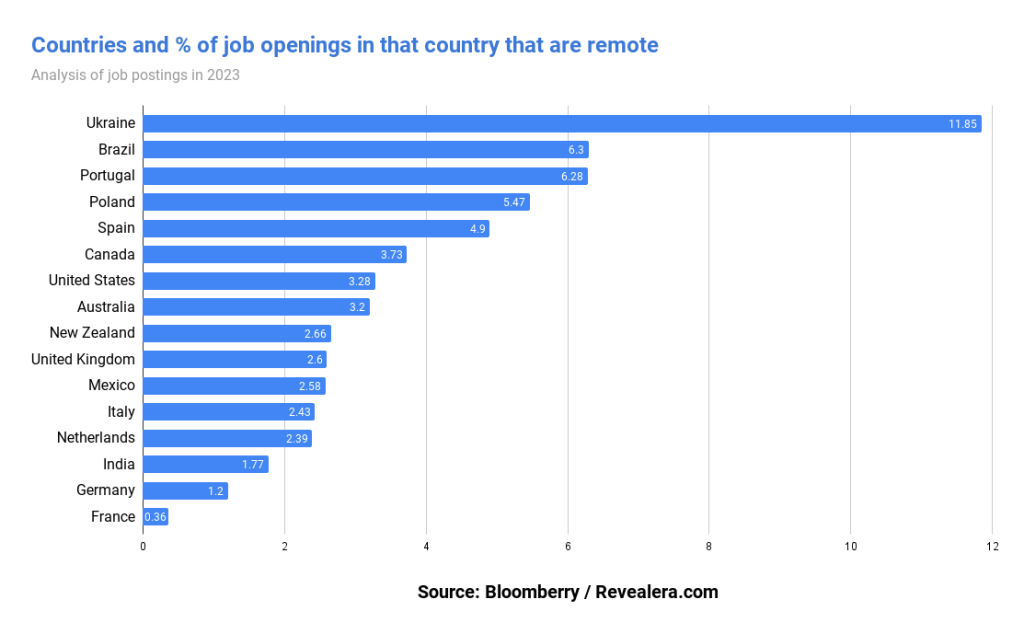
Which countries lead the way when it comes to remote work? Among countries with at least 1000 remote job openings last year, Ukraine, Brazil, and Poland led the way. On the other hand, Australia, India, and France were among the countries with the lowest % of remote job openings. I thought it would be interesting to compare this with the best countries for remote work published by Remote.com. The 2 countries that made it to the top 5 in both lists were Spain and Portugal.
Compared to 2022, there really wasn’t much of a difference. But the countries with the largest growth in % of remote job openings were New Zealand, Portugal, and Spain. Countries with the largest decline in % remote jobs were Poland, Canada and Italy.
Remote Jobs from US Companies have mostly stayed inside the US
Are US companies hiring more remote workers from overseas? I measured the % of remote jobs from US-based companies that are based inside the US, and the % has remained steady at 75% since 2020.
While globalization is a significant force, for remote work, there’s still a strong inclination towards hiring within the national borders, potentially for reasons of legal compliance, logistical simplicity, and workforce management.
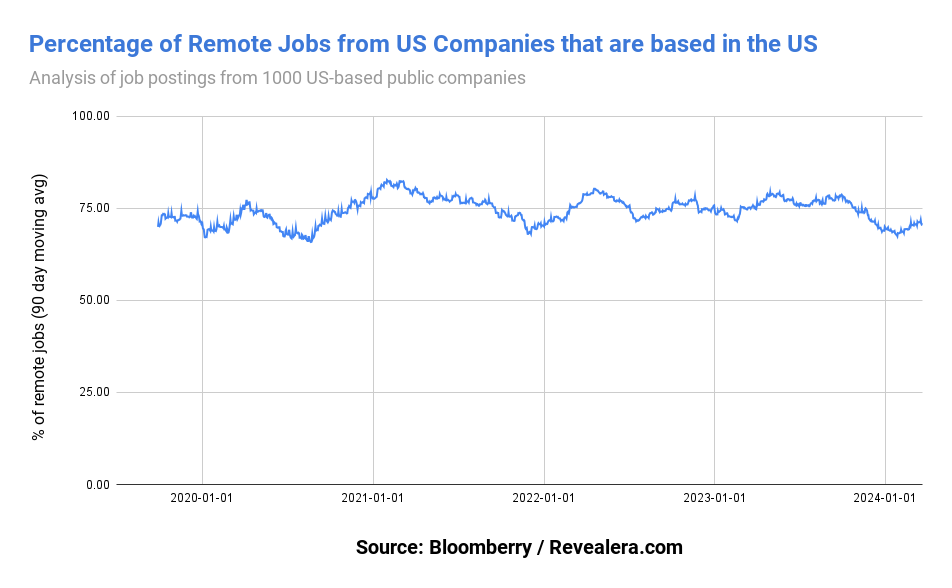
This trend is pretty consistent, no matter what type of jobs I looked at, whether it was software engineering or customer service.
Companies with a mostly remote work culture had an average Glassdoor rating of 3.8 vs 3.4 for the average company
Does remote work correlate strongly with work satisfaction? I analyzed 100 companies with the highest % of remote jobs overall, and their average Glassdoor rating was 3.8, which is higher than the average Glassdoor rating of 3.4 for all companies.
Correlation isn’t causation, and of course compensation, benefits, and work-life balance all matter, but this does suggest a strong relationship between having a remote work culture and work satisfaction.
Unfortunately, I wasn’t able to pick out companies that had a hybrid work policy easily, but it would’ve been interesting to see if fully remote companies had higher satisfaction ratings than companies with hybrid work policies.

